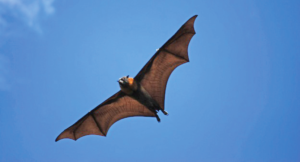Animal names are always intriguing and descriptive. Some lizards, for example, are called ‘dragons’ because they look like the most popular portrayals of the mythological creature. Other animals are named for their most distinctive trait, like a striking color or prominent body part.
And then there are the flying foxes. The first thing you should know about them is that they’re not actually foxes! Flying foxes are actually bats, but they have fox-like faces, hence the name. Some people call them ‘foxes with wings’.

Flying foxes belong to the genus Pteroptus of the megabat sub-order Megachiroptera; they are the largest bats in the world.
The Philippines is home to nine known species of flying foxes. The Mindoro pallid flying fox is one of the smallest in the world. Also found locally is one of the world’s biggest bats: the giant golden-crowned flying fox.
Like much of Philippine wildlife, the golden-crowned flying fox is endangered due to poaching and forest destruction. Before they disappear, let’s take a closer look at this fascinating Philippine bat.
1. It has many names!
Its scientific name is Acerdon jubatus. It is sometimes called a ‘golden-capped fruit bat’. They have also been called ‘The Silent Planter’ because they are “known to scatter the seeds of the fruit they eat in their dropping; this makes them vital to the ecosystem of the Philippines’ rainforests.”
2. It really is a giant bat!
It’s one of the largest bats in the world, with a wingspan of about 5 feet. They can weigh up to 1.2 kilograms. Male bats are larger and heavier than the females. They have a claw on the second digit of each wing, and they have sharp and pointed teeth, except for their last two molars.
3. It’s all in the name.
Like most flying foxes, it has a doglike face and large eyes. It’s called ‘golden-crowned’ or ‘golden-capped’ because it has golden-tipped hairs on the top of its head, as well as an orange-yellow patch on the back of its neck. The golden parts are a striking contrast to the rest of the bat: brownish-black fur on the other parts of the head and the reddish-brown fur on its back. The fur on the underside of its body is blackish, with silver-tipped hairs. Yellow hairs can also be found throughout its body, especially its lower body.
4. Only in the Philippines!
This bat is unique to the Philippines. They used to be seen all over the country, but now that they’re endangered, they’ve completely disappeared from some islands, like Cebu. The Department of Environment and Natural Resources (DENR) keeps a close watch for sightings. In 2014, some were spotted at the mangrove forests of Barangay Tigbucay in Tungawan, Zamboanga Sibugay, and the villages of Palompon, Leyte.
5. Bats seek sanctuary.
There are sanctuaries where the bat can be seen, such as the Tabuk Marine Park and Bird Sanctuary in Leyte. Many are seen flying around the protected areas of Subic, Zambales, which is also a roost site. Other roost sites are Boracay and Mambukal, Negros Occidental. The DENR has recorded about nine roost sites all over the country. These bats only produce young once every two years in captivity. In the wild, they probably reproduce less often.

6. They like to hang out.
The giant golden-crowned flying fox is a sociable creature. They live in large colonies which often include another kind of bat, the Malayan flying fox (Pteropus vampyrus). They cluster together for warmth and protection, and colonies are made up of thousands of bats.
In the 1920s, one colony was recorded with over 150,000 bats!
7. Save the bats!
This species is considered endangered, mainly due to excessive hunting. Because of their large colonies, it’s very easy to hunt and destroy them in large numbers. Hunters usually attack them by day, when they’re sleeping. Habitat loss is a big problem too—especially since one of their roost sites is Boracay, which has lost over 50% of its for est cover in the last ten years! They like to roost in hardwood trees, “often on cliff edges or steep, inaccessible slopes.
Other preferred roosting sites include bamboo clumps, mangrove trees, and other swampy forested areas. Roosting sites are usually located on smal l, offshore islands.” With such areas often giving way to urban or tourist developments, the bats are running out of places to live.
8. They’re fruity!
Giant golden-crowned flying foxes are frugivores, or fruit-eaters. Figs are their favorite! They travel long distances at night to find food. Figs “are only found in mature lowland forests,” so where fig plants are found, giant golden-crowned flying foxes are sure to be hanging out nearby.
9. They see you!
These bats have one advantage over others: they have good eyesight! “The golden-capped fruit bat navigates its way around the forest and locates food using its good vision, without utilizing echolocation as many other bat species do.”
10. Squeaky clean!
They love bath time! They frequent river areas, and spend a lot of time around water. They use their large wings to scoop up water to wash themselves.
Resources and Additional Reading:
There’s a lot of information available online when it comes to golden-crowned flying foxes. But if you look closely, there’s still a lot that’s unknown about them. We still don’t know how long their gestation periods are, their impact on local ecosystems, their life expectancy, or their mating systems. There’s still a lot to learn, and hopefully conservation efforts can help save this species. Here’s a list of where you can start:
* http://www.batworlds.com/giant-goldencrowned-flying-fox/
* http://www.sospecies.org/sos_projects/mammals/filipinos_for_flying_foxes/
* http://www.factzoo.com/mammals/giantgolden-crowned-flying-fox-fruit-worldslargest-bat-endangered.html
* http://whatsnextph.org/blog/2013/12/featured-species-the-giant-golden-crownedflying-fox
* http://www.big-animals.com/giant-goldencrowned-flying-fox/
* http://haydensanimalfacts.com/2014/08/31/5-interesting-facts-aboutgiant-golden-crowned-flying-foxes/
* http://eol.org/pages/327307/details
* http://lakbaypilipinas.com/flora_and_fauna/philippine-flying-foxes.html
* http://pbcfi.org.ph/philippine-bats
* http://expeditions.fieldmuseum.org/islandmammals/philippine-biodiversity
* http://www.mb.com.ph/feature-giant-batsnow-back-to-palompon-leytes-tabuk-marinepark-and-bird-sanctuary/
* http://www.mb.com.ph/rare-fruit-batsighted-in-tungawan/
* http://www.greatersubic.com/index.php/directory-listings/things-to-do/78-subic-bayflying-foxes
* http://r9.denr.gov.ph/index.php/86-regionnews-items/212-denr-ix-confirms-presenceof-golden-crowned-flying-fox-in-zamboangasibugay
This appeared in Animal Scene’s February 2016 issue.






